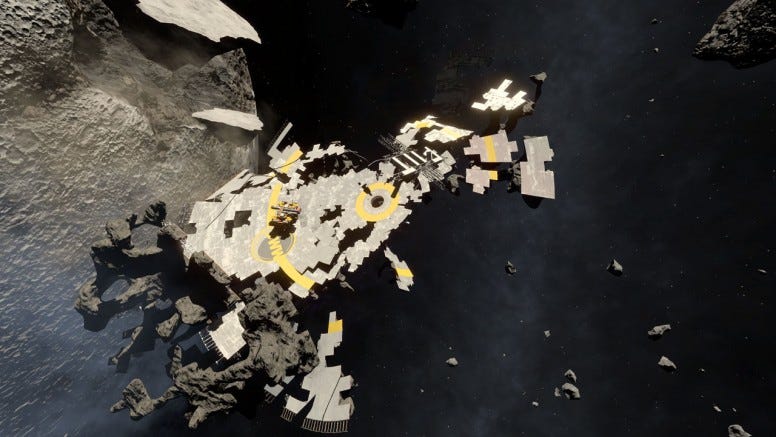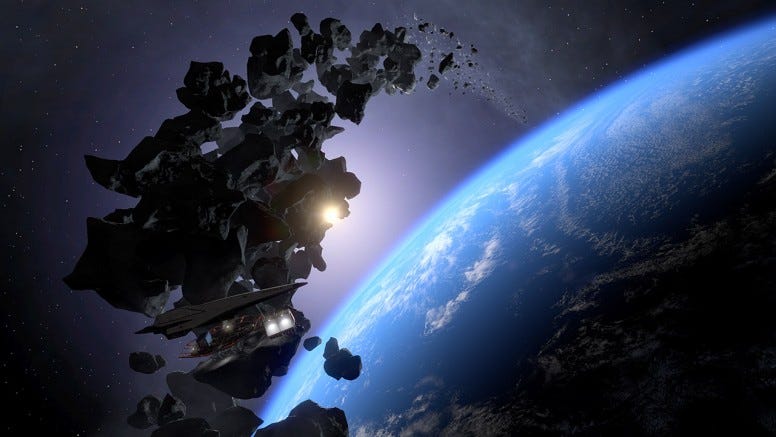Shattered Horizon, the sci-fi FPS from Futuremark (now UL Solutions), was a game I saw a lot of in the run-up to, and post, release. A beautiful game that took simple gameplay mechanics and, with clever use of gravity and fully three-dimensional environments, looked set to revolutionise the landscape. Fast forward four years and Shattered Horizon has mere dozens of active players, with Futuremark having bowed out of game development with their studios now owned by Angry Bird creators Rovio Entertainment.
Did something go wrong in that time? Did people not like Shattered Horizon? I spoke with James Gallagher of Futuremark Studios to talk about Shattered Horizon; its conception, its launch, its successes, and ultimately, its failings.
“‘Futuremark Games Studios’ was announced in January 2008… though work on Shattered Horizon had started earlier than that.” A studio renowned for its work with benchmarks, Futuremark would hardly seem the nesting ground of a revolutionary FPS, but James explained that “the jump from 3DMark (Futuremark’s benchmark) to making games was not such a big one. It was something many in the team wanted to do, and we already had many of the skills needed in-house.” It was a bullish proposition; a studio with little gaming experience emerging into the most crowded of genres: first-person shooters. Having listened to James’s ‘pitch’ however, the appeal was obvious:
“We decided that a skill-driven, multiplayer [only] FPS was the right way to go. The zero-gravity space setting would give players the freedom to play in new ways. Fully three-dimensional level design and complete freedom of movement would enable new and innovative tactics not found in other FPS games. Our aim was to make zero gravity combat fun, with simple controls that any FPS player would quickly and intuitively understand.”
Shattered Horizon Is Born
The biggest draw for me was that the noise of the FPS genre was stripped back. Shattered Horizon 1.0 had only one rifle, one pistol, and one melee weapon. The game’s dynamism came through intelligent movement and understanding of the fully three-dimensional map. “Much of the design of Shattered Horizon was from necessity,” James explains, “We had to be careful not to over-design the game or pack it full of features because we were just a small team.” The “do it all gun,” as James puts it, is a result of that mantra. It was a result of that decision that drew me to the game; I don’t enjoy perks, I hated unlocks, and I didn’t enjoy the now commonplace battle pass model. If I’m good at the game my score will tell me that, not how much “experience” I get for completing arbitrary tasks or how many times I prestige.
Unfortunately for Futuremark, I was in the minority; “We spent a lot of time reading the reviews and forum threads. We found there were a few common themes that came up again and again. First, people felt that the game didn’t have enough content as we launched with four maps in total. Second, there wasn’t enough variety in the combat, with people specifically calling out the single gun load-out. And finally, since the game was a pure multiplayer title, some reviewers [deducted points] for the lack of single-player story or content.”
On this, the eve of Titanfall’s launch, the latest gaming media darling from Respawn Entertainment, the final point seems unfair, if not completely misguided. Futuremark took the criticism to heart and was faced with a decision to make; “One option was to focus on esports communities,” James explained. “The audience liked the single gun model since it put more focus on player skill. [Choosing] that route would have seen us prioritise updates to enhance the competitive side of the game. More stats, ranks, clan support, tournament mode, spectator mode, and so on.” As James was reeling off this option my mouth salivated a little, I was the target audience for this path, but I knew what was coming; “However, those changes risked making the game less appealing to more casual players… [and] the chances of making enough to sales to fund our next game were much lower.”
What Futuremark did decide to do was to try and increase the game’s appeal by “adding content, variety and making the game more accessible.” That final word can carry negative connotations, but in this instance, it meant only good things for the player base.“We released a series of free DLC updates to Shattered Horizon. The Moonrise pack doubled the number of maps to eight. The Firepower pack introduced new weapons and grenades. And the Last Stand pack added single-player options against bots.” It was a commendable development decision, with Futuremark choosing to keep its player base as one, rather than fragment it through paid DLC. “Our goal [with these updates] was to get the community up to a critical mass. If you have a solid community of players, of all skill levels, then it’s easier to attract new players.”
Those new players didn’t come, however. Despite the DLC, despite free weekends and sales on Steam something about Shattered Horizon never quite clicked with the community. Did the game have any crucial failings that players didn’t enjoy? It’s difficult to tell from my point of view; that original version of Shattered Horizon, one gun and all, remains one of my definitive FPS experiences. Futuremark, and Shattered Horizon, could well be seen as victims of circumstance.
From Concept To Reality
“Our mantra was ‘A sci-fi game you can believe in.’ It sounds clichéd, but Shattered Horizon’s intention was to be as grounded in reality as possible; near future, no aliens, no space marines, just “two factions stranded in space, each with little chance of survival.” Futuremark had a couple of key goals in the genesis of the game; to keep it grounded, “to convert real-world technology and the laws of zero-gravity physics into an accessible and fun game” and “because we are Futuremark” the game had to be stunning. “It would be one of the first games to require DirectX 10″ James told me, and we’d immediately touched on one of Shattered Horizon’s biggest undoings.
Shattered Horizon required DirectX 10, exclusive to Windows Vista and, as James recognised, “Vista wasn’t a hit with PC gamers.” Immediately Futuremark were at a disadvantage; “Windows 7 came out in October 2009, a month before we released [Shattered Horizon.] Windows 7 was a big improvement over Vista, and gamers were much more enthusiastic about DirectX 11.” It left Futuremark in an awkward position; “We couldn’t delay releasing the game… but according to the Steam Hardware Survey at the time, only 50% of players had PCs that were even capable of running it. Our only option was to release and hope that more gamers would upgrade.” It was a massive gamble and one that, ultimately, wouldn’t pay off.
James remains proud of Shattered Horizon though, and of the things that Futuremark achieved in that time. “Shattered Horizon was a hugely ambitious game for a team making their first title… We learned so much, from design to development, to processes and teamwork.” It was a process, and a journey, that would define Futuremark Game Studio’s legacy; “In the studio, our guiding rule was that our games should bring new ideas to popular genres.”
Bad Timing
I touched earlier on the idea that Shattered Horizon, and Futuremark in general, could well have been victims of circumstance; DirectX 10 had a slow uptake, the free-to-play scene was non-existent, esports wasn’t as big as it is now and, crucially, crowd-funding (popularised by Kickstarter) “wasn’t an obvious route for indie developers like it is today.” James revealed that the “goal was to create a sequel to Shattered Horizon… [and] self-fund some smaller games” to fund the studio while they searched for a publisher.
“Mobile was really starting to take off on iOS around this time… The first of these self-funded games was Hungribles, a skill-shot puzzle game for iPhone and iPad designed to appeal to casual mobile players.” A coveted ‘Game of the Week’ place on the Apple Store guaranteed a win for Futuremark, while Unstoppable Gorg was also well received. Rumbling in the background, however, was “slow and continual process for a couple of years” in trying to secure a publisher for a Shattered Horizon sequel.
“We had a concept for a story-driven, single-player Shattered Horizon experience that we brought to life with concept art and design documents” (And yes, I asked James to share them, but the answer was a polite no). Publishers, however, wanted something more concrete; “And there’s the rub. You need money to begin development, but it’s exceptionally difficult to get a deal unless your game is already playable.” A catch-22 situation, exacerbated by a terrible economic situation; “There were very few publishers looking to sign new titles, and even those who showed interest were exceptionally risk averse.”
It’s a heartbreaking situation, and one can only imagine the damage it must have caused to the morale at Futuremark. They soldiered on though and by mid-2011 had a vertical slice to show to publishers; “The slice contained everything that would appear in the finished game – gameplay, graphics, audio, scripting, AI, physics, and so on.” (Again, I asked…) Futuremark even changed their pitch depending on who they were meeting with; “from enhanced multiplayer, to episodic releases, to digital distribution and so on.”
No publisher picked up the title.
Angry Birds, Shattered Horizons
“Rovio were not one of the companies we pitched to. I can’t go into details of the deal, other than to say when the opportunity came along it was too good to pass up.” You could never begrudge such a decision, especially considering the run of luck Futuremark had in Shattered Horizon’s lifetime, but one can’t help feeling disappointed. “Futuremark is completely focused on benchmarks now,” James told me, and while they still own the rights to Shattered Horizon and their other IPs there are “no plans to make any updates, expansions or new games,” and, more crushingly, “we’ll probably stop offering customer support for the game at some point this year too.”
Despite James’s professionalism I can’t help but notice, alongside his pride, a tinge of sadness; “Looking back now, four years later, the thing I’m most proud of is that Shattered Horizon is still a completely original game and concept. Maybe someday, someone will have a go at making another zero-gravity shooter, but for now, Shattered Horizon still offers a unique experience.” The two of us mused, briefly, “Who knows how things might have turned out had we released the game a year or two later?” I certainly don’t, but I remain steadfast in my belief that had more people played Shattered Horizon the discussion James and I were having would have been over champagne, rather than email.
But what of the talent behind the game? It would be a shame to end on a down note, after all, Shattered Horizon remains a wonderful game. “Jaakko Haapasalo is now Head of the Studio at Rovio. Shattered Horizon’s lead programmer is now.. at RedLynx, working on the Trials games. Two of our guys formed Almost Human… and released Legend of Grimrock [and] another pair formed Theory Interactive, who just got their first title, RESET, crowd-funded on Indiegogo.”
Futuremark may be focused on benchmarks, but their legacy continues through a number of excellent avenues. I remain hopeful that one day we’ll see those materials for a Shattered Horizon sequel, but more so I hope that people remember the title for what it was; a pioneer in simplicity and technology. A stunning tribute to the first-person genre and PC gaming as a whole, and a reminder to both players and publishers that quality exists in the most unlikely places.
I’d like to thank James Gallagher for being a great sport throughout this process.









